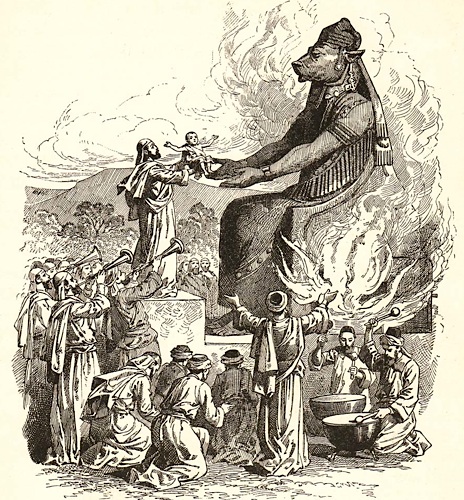 This is the kind of thing that drives me crazy. A press release is put out making the claim that a new study "debunks millennia-old claims of systematic infant sacrifice in ancient Carthage." Sounds intriguing, right?
This is the kind of thing that drives me crazy. A press release is put out making the claim that a new study "debunks millennia-old claims of systematic infant sacrifice in ancient Carthage." Sounds intriguing, right?Then, you read the release. About half-way down is this very curious statement:
"The idea of regular infant sacrifice in Carthage is not based on a study of the cremated remains, but on instances of human sacrifice reported by a few ancient chroniclers, inferred from ambiguous Carthaginian inscriptions, and referenced in the Old Testament."Ok, do you get that? Apparently, documentary evidence in written sources dating from thousands of years ago is now considered inferior to scant archaeological remains--at least by these guys.
For the record, here is one of the pieces of documentary evidence of Carthaginian child sacrifice, taken from Diodorus Siculus:
In their zeal to make amends for their omission, they selected two hundred of the noblest children and sacrificed them publicly; and others who were under suspicion sacrificed themselves voluntarily, in number not less than three hundred. There was in their city a bronze image of Cronus, extending its hands, palms up and sloping toward the ground, so that each of the children when placed thereon rolled down and fell into a sort of gaping pit filled with fire.Child sacrifice is also mentioned in Sacred Scripture as being associated with the Caananite god, Moloch, for example:
"Thus shalt thou say to the children of Israel: If any man of the children of Israel, or of the strangers, that dwell in Israel, give of his seed to the idol Moloch, dying let him die: the people of the land shall stone him." Leviticus 20:2Here is a list of references to Moloch in Scripture.
http://www.drbo.org/cgi-bin/s?t=0&q=moloch&b=drb
Carthage was a colony of the Caananite/Phoenician trading cities.
But there is a real zinger in this press release:
"Our results show that some children were sacrificed, but they contradict the conclusion that Carthaginians were a brutal bunch who regularly sacrificed their own children."Did you get that? So far from debunking anything, the research actually confirms that the Carthaginians did practice child sacrifice. The best this research team can do is comfort themselves with the knowledge that it may not have been on a massive scale.
Good grief.

3 comments:
Love this piece of information.
I regret to tell you that you are misinformed. The Carthaginians were not savage people as you call them. They were more civilized than the Romans. Because the Romans defeated them, they made up stories about child sacrifice. Recent discoveries show that fetuses were discovered among the bodies of dead children whom everybody supposes that they were living sacrifices. In fact, dead children and fetuses or stillborns were surrendered to the god's care.
Remember, Saint Augustine was a Carthaginian and he said "There was a great deal of wisdom in Punic books", besides he called the Punic language "Our own tongue." Meanwhile, you call the same people savages when their city, Carthage was the jewel of the Mediterranean with its port unrivaled anywhere in the old world. Comparatively speaking, the Romans were peasants when the Carthaginians were in their heyday.
Finally, remember that when Carthage was defeated in 149 A.D., it was burned to the ground by savage Romans. It took the Punic Carthaginians 260 years to rule the whole Roman Empire when Emperor Septimius Severus became emperor and was followed by his dynasty of Severus Emperors. Study and be open to new ideas when they are proven with new research. Those who cannot change will fossilize and die like the dinosaurs.
Cyril May -- Where did I call the Carthaginians "savages"? While that epithet may be appropriate given that they did practice infant sacrifice, I did not use it in the posted piece above.
For the record, since I published this in 2010, scholars have come to the consensus that the Carthaginians did practice infant sacrifice after all. Sorry to burst your bubble. See the article below from the University of Oxford:
Ancient Carthaginians really did sacrifice their children
It's one thing to study and be open to new ideas. It's another to be duped by revisionist history that lacks evidence to support it. Those who do that end up believing in unicorns and pixie dust.
Post a Comment